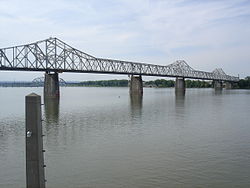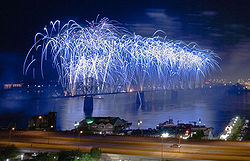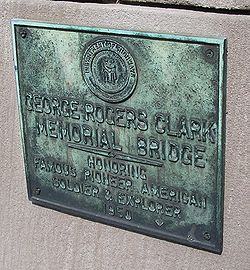- George Rogers Clark Memorial Bridge
-
George Rogers Clark Memorial Bridge 
The George Rogers Clark Memorial Bridge as seen from Louisville Waterfront ParkCarries 4 lanes of US Route 31 Crosses Ohio River Locale Louisville, Kentucky and Jeffersonville, Indiana Design Cantilever bridge Total length 5,746.5 ft (1,751.5 m) Width 38.0 ft (11.6 m) Longest span 819.6 ft (249.8 m) Opened 1929 Coordinates 38°15′49″N 85°45′05″W / 38.26361°N 85.75139°WCoordinates: 38°15′49″N 85°45′05″W / 38.26361°N 85.75139°W  The Clark Memorial Bridge during Thunder Over Louisville
The Clark Memorial Bridge during Thunder Over Louisville
The George Rogers Clark Memorial Bridge is a four-lane cantilevered truss bridge crossing the Ohio River between Louisville, Kentucky and Jeffersonville, Indiana, that carries US 31. It is known locally as the Second Street Bridge.
Contents
History
It was designed by Ralph Modjeski and Frank Masters with architectural details handled by Paul Philippe Cret of Philadelphia, and construction began in June 1928 by the American Bridge Company of Pittsburgh at a cost of $4.7 million. It was opened to the public on October 31, 1929 as the Louisville Municipal Bridge and operated as a toll bridge. The toll was 35 cents until December 31, 1936, when it became a quarter. The last of the bonds that financed the construction were redeemed in 1946, and the tolls were removed.
In 1949, the bridge was renamed in honor of George Rogers Clark, recognized as the founder of Louisville.[1]
The bridge was rehabilitated in 1958.
There was a movement in the 1950s to restore tolls, as traffic on the bridge had reached capacity and funding was needed for an additional bridge, but a toll was opposed strongly by most residents. Ultimately most of the funds for two additional bridges (for motor vehicles only) that carry interstate highways came from the federal government.
It was placed on the National Register of Historic Places on March 8, 1984.
In June 2010, Kentucky Governor Steve Beshear and Louisville Mayor Jerry Abramson announced a new $3 million streetscape improvement project directly underneath the Clark Memorial Bridge, a three-block area from Main Street to River Road, which will be transformed into a plaza. This includes a new decorative lighting system under the refurbished Clark Memorial Bridge, wide sidewalks, seats, new pedestrian and festival areas, and extensive plantings, making this an inviting promenade for the new KFC YUM! Center. The project was completed in time for the October 2010 opening of the arena.[2]
Culture
Locally, the Clark Bridge is also known as the Second Street Bridge, as Louisville's Second Street leads directly to the bridge. This has never been a formal name, however. There is a pedestrian sidewalk on each side of the bridge deck. The Clark Bridge is the only regional Ohio River bridge currently open to non-motorized traffic.
Since 1991, the bridge has been used as "ground zero" for the annual Thunder Over Louisville event, when a waterfall of fireworks flows along the entire length of the bridge during the fireworks show. This involves traffic being closed for much of the week. This is criticized as it cuts off both the only non-interstate and the only pedestrian route between Louisville and southern Indiana, which can impact local businesses such as bicycle couriers.
The bridge is featured in a scene from the 1981 movie Stripes in which Bill Murray drives his cab to the middle of the span, gets out of the vehicle and then tosses his keys into the river below.[3]
See also
Notes
- ^ Luhan. pp. 105.
- ^ "Second Street Transformation to Occur Near arena". http://www.louisvilleky.gov/economicdevelopment/News/2010/TransformationonSecondStreettoTakePlace.htm.
- ^ "Second Street to Third Street". http://louisville.about.com/od/communityandneighborhoods/ss/MainStTour_4.htm. Retrieved 2007-02-22.[dead link]
References
- Allgeier, M.A. (1983). Louisville Municipal Bridge, Pylons, and Administrative Building. Louisville, KY: Louisville Landmarks Commission. http://pdfhost.focus.nps.gov/docs/NRHP/Text/84001578.pdf.
- "Automobile Bridges" (1 ed.). 2001.
- Luhan, Gregory A. (2004). Louisville Guide. Princeton Architectural Press. ISBN 1568984510. http://books.google.com/books?id=fai4OHydKKIC.
External links
- George Rogers Clark Memorial Bridge at KentuckyRoads.com (unofficial)
- Louisville Art Deco page on Municipal Bridge Building and Pylons
Bridges of the Ohio River Upstream
John F. Kennedy Memorial Bridge

George Rogers Clark Memorial Bridge

Downstream
Fourteenth Street Bridge
Louisville and Indiana RailroadU.S. National Register of Historic Places Topics Lists by states Alabama • Alaska • Arizona • Arkansas • California • Colorado • Connecticut • Delaware • Florida • Georgia • Hawaii • Idaho • Illinois • Indiana • Iowa • Kansas • Kentucky • Louisiana • Maine • Maryland • Massachusetts • Michigan • Minnesota • Mississippi • Missouri • Montana • Nebraska • Nevada • New Hampshire • New Jersey • New Mexico • New York • North Carolina • North Dakota • Ohio • Oklahoma • Oregon • Pennsylvania • Rhode Island • South Carolina • South Dakota • Tennessee • Texas • Utah • Vermont • Virginia • Washington • West Virginia • Wisconsin • WyomingLists by territories Lists by associated states Other Categories:- Bridges completed in 1929
- Bridges in Louisville, Kentucky
- Cantilever bridges
- Bridges over the Ohio River
- Bridges on the National Register of Historic Places in Indiana
- Bridges on the National Register of Historic Places in Kentucky
- National Register of Historic Places in Clark County, Indiana
- National Register of Historic Places in Louisville, Kentucky
- Monuments and memorials in Indiana
- Monuments and memorials in Kentucky
- Memorial bridges in the United States
- Paul Philippe Cret buildings
- Buildings and structures in Clark County, Indiana
- Transportation in Clark County, Indiana
- Road bridges in Indiana
- Road bridges in Kentucky
Wikimedia Foundation. 2010.

